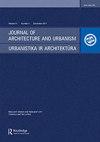(重新)将空间性作为一种社会文化范式:审视伊朗的住房文化和过程
IF 0.8
0 ARCHITECTURE
引用次数: 3
摘要
随着当今城市生活的快速变化,人们的行为模式和空间实践经历了一个不断适应和协商的过程。本文将“房子”作为实验室,将居民的日常生活和空间关系作为分析框架,探讨了传统和当代伊朗建筑中的空间规划概念以及相关的社会文化实践。讨论来自于在克尔曼市进行的一项试点研究,旨在调查当代住房解决方案如何更好地满足居民不断变化的社会文化生活方式。该研究的数据收集涉及一系列参与性讲习班,并采用创造性的视觉研究方法、参与性观察和半结构化访谈,以检查日常社会空间关系的交织以及对身份、归属、社会文化和宗教价值观和冲突的不断变化的看法。从研究中得出的结论显示了新兴的社会和文化需求以及人们通过居民、他们居住的地方及其空间规划和组织之间的复杂关系表现出来的实践。为了更好地理解这种复杂的关系,本文认为有必要将空间性作为一种社会文化范式加以恢复。本文章由计算机程序翻译,如有差异,请以英文原文为准。
(RE)FRAMING SPATIALITY AS A SOCIO-CULTURAL PARADIGM: EXAMINING THE IRANIAN HOUSING CULTURE AND PROCESSES
With rapid changes in urban living today, peoples’ behavioural patterns and spatial practices undergo a constant process of adaptation and negotiation. Using “house” as a laboratory and everyday life and spatial relations of residents as a framework of analysis, the paper examines the spatial planning concepts in traditional and contemporary Iranian architecture and the associated socio-cultural practices. Discussions are drawn upon from a pilot study conducted in the city of Kerman, to investigate ways in which contemporary housing solutions can better cater to the continually changing socio-cultural lifestyles of residents. Data collection for the study involved a series of participatory workshops and employed creative visual research methods, participant observation and semi structured interviews to examine the interlacing of everyday socio-spatial relations and changing perception of identity, belonging, socio-cultural and religious values and conflict. The inferences from the study showcases the emerging social and cultural needs and practices of people manifested through the complex relationship between residents, the places in which they live, and its spatial planning and organisation. For a better understanding of this complex relationship, the paper argues the need for resituating spatiality as a socio-cultural paradigm.
求助全文
通过发布文献求助,成功后即可免费获取论文全文。
去求助
来源期刊

Journal of Architecture and Urbanism
ARCHITECTURE-
CiteScore
1.30
自引率
14.30%
发文量
12
审稿时长
15 weeks
期刊介绍:
The Journal of Architecture and Urbanism publishes original research on all aspects of urban architecture.
 求助内容:
求助内容: 应助结果提醒方式:
应助结果提醒方式:


